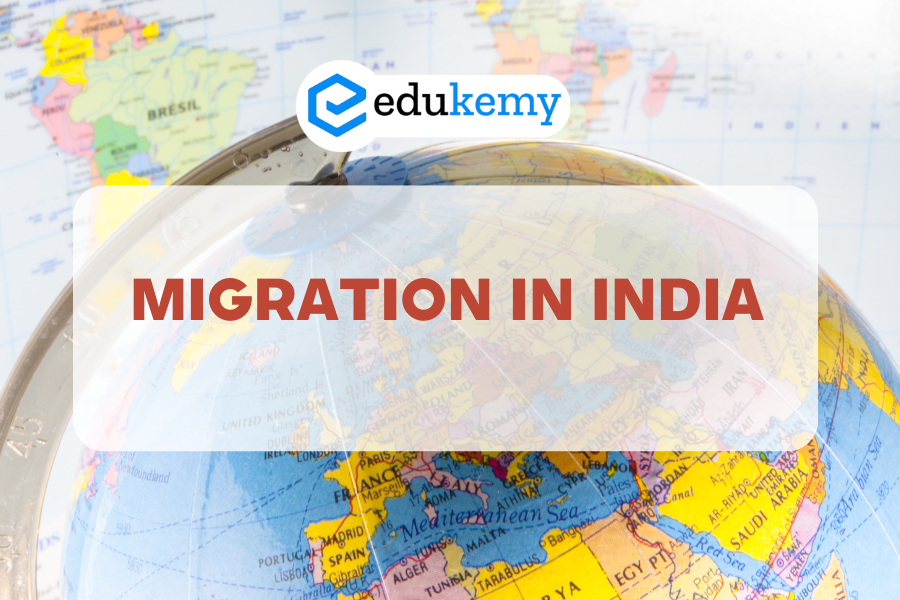Explore the patterns, causes, and theories of migration in India, with a detailed case study to understand its impact on demographics and socio-economic trends.

Contents
Introduction
Migration has long been a defining feature of human societies, and in India, it has shaped the demographic and socio-economic landscape for centuries. Understanding the patterns and causes of migration in India is crucial for Geography Optional students preparing for the UPSC examination. This blog will delve into the concept of migration, theories applicable in the Indian context, and provide a case study to give practical insights into migration trends.
Check Shabbir Sir’s Class Notes
Click Here to download
What is Migration?
Migration refers to the movement of people from one place to another, either temporarily or permanently, in search of better living conditions, employment, education, or due to forced displacement caused by natural disasters or conflicts. In the Indian context, migration is a complex phenomenon shaped by a range of social, economic, political, and environmental factors.
Types of Migration in India
- Internal Migration: This involves the movement of people within the country, often from rural areas to urban centers in search of better economic opportunities.
- International Migration: This type of migration involves people moving from India to other countries for employment, education, or familial reasons. The Middle East, the United States, and Europe are common destinations for Indian migrants.
- Rural to Urban Migration: With India’s rapid urbanization, a significant portion of internal migration occurs from rural areas to cities and towns, primarily driven by the search for better livelihoods and improved living standards.
- Seasonal Migration: A major feature of rural migration in India, this refers to the movement of people (often farmers or laborers) to urban areas for work during off-seasons or agricultural downtimes.
- Forced Migration: This includes migration caused by environmental factors (such as floods, droughts, or earthquakes) or conflict (like communal violence or wars).
Theories of Migration Applicable to India
Several theories of migration can be applied to understand migration patterns in India, especially in the context of economic and social changes. Some of the most relevant theories include:
- Ravenstein’s Laws of Migration (1885): These laws highlight that most migrants move short distances within their own country, and those who move longer distances often settle in urban areas. This theory is particularly relevant in India, where there is a significant rural-to-urban migration. However, the concept of “counter-flow,” where migration from cities to rural areas also occurs due to reverse migration in times of crisis, is also significant.
- The Push-Pull Theory (Everett Lee, 1966): This theory explains migration in terms of “push” factors (negative aspects of the origin, such as poor employment opportunities, poverty, or natural disasters) and “pull” factors (positive aspects of the destination, like better job prospects, education, and living conditions). In India, the migration from rural to urban areas is largely driven by push factors such as limited agricultural income, while pull factors include industrial growth in cities like Mumbai, Delhi, and Bengaluru.
- World System Theory (Immanuel Wallerstein): This theory suggests that migration patterns are influenced by the global economic system. It argues that people migrate from peripheral (rural) areas to core (urban) areas of the economy in search of opportunities created by economic globalization. In India, migration from rural villages to urban centers can be explained through this lens, with industrial hubs attracting migrant labor.
- Dual Labor Market Theory: This theory distinguishes between primary and secondary labor markets. The primary market offers well-paying, stable jobs, while the secondary market consists of low-wage, unskilled labor jobs. Migration within India, particularly from rural to urban areas, can often be linked to the search for opportunities in the secondary labor market. In cities like Delhi and Mumbai, migrants often work in the informal economy, including construction, domestic work, and small businesses.
- Social Networks Theory: This theory emphasizes the role of social networks in facilitating migration. Migrants often move to areas where relatives or friends already reside, which helps reduce the risks and uncertainties associated with migration. This is especially true in India, where migration networks between rural and urban areas, as well as between India and countries like the UAE, the USA, and the UK, are very strong.
Case Study: Migration to Urban Areas in Mumbai
One of the most compelling case studies of migration in India is the urbanization of Mumbai, the country’s financial capital. Mumbai has attracted millions of migrants over the decades, driven by the pull factors of employment in the booming textile and service sectors, as well as the promise of better living standards.
Push Factors:
- Agricultural Decline: Farmers from rural Maharashtra and neighboring states like Uttar Pradesh and Bihar migrate to Mumbai due to the decline in agriculture and the lack of land.
- Poverty and Unemployment: High levels of poverty in rural areas, coupled with limited job opportunities, push people to seek employment in the city.
Pull Factors:
- Economic Opportunities: Mumbai, being the economic hub of India, offers numerous job opportunities, especially in industries such as textiles, IT, film (Bollywood), and services.
- Better Infrastructure: Despite challenges, the city offers better housing, education, and healthcare compared to rural areas.
Impact of Migration:
- Economic Contribution: Migrants contribute significantly to the city’s economy, especially in sectors like construction, domestic work, and small-scale industries.
- Slum Formation: Overpopulation has led to the formation of slums, where migrants live in overcrowded and unsanitary conditions. The largest slums, like Dharavi, are home to millions of people.
- Social Integration Issues: Migrants often face challenges related to social integration, including discrimination, lack of access to services, and strained infrastructure.
Conclusion
Migration in India is a multifaceted phenomenon shaped by a complex interplay of economic, social, political, and environmental factors. For UPSC Geography Optional students, understanding migration theories like Ravenstein’s Laws, the Push-Pull Theory, and the World System Theory can provide valuable insights into migration patterns. Case studies like the urbanization of Mumbai illustrate how migration impacts both the source and destination areas, influencing social and economic dynamics. A deep understanding of these patterns is essential for analyzing India’s ongoing demographic and urban challenges, making migration a key topic for UPSC preparation.
To get free counseling/support on UPSC preparation from expert mentors please call 9773890604
- Join Geography Optional Course – Click Here
- Get Geography Hard Copy notes – Click Here

